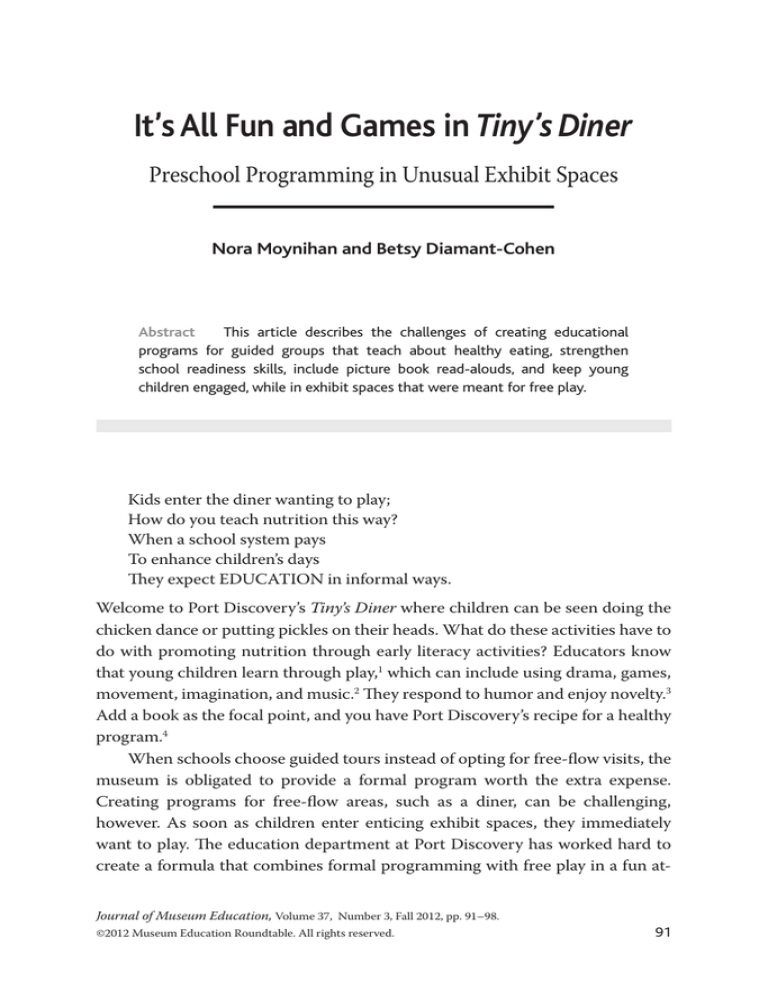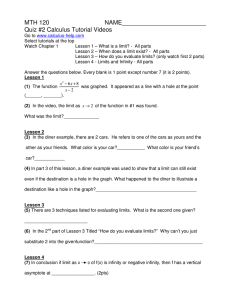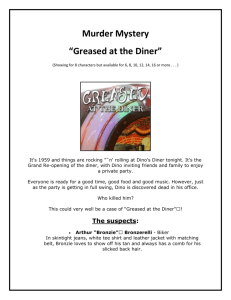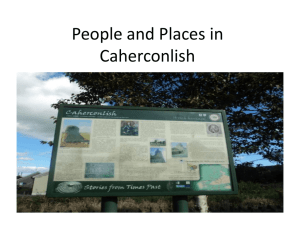
It’s All Fun and Games in Tiny’s Diner
Preschool Programming in Unusual Exhibit Spaces
Nora Moynihan and Betsy Diamant-Cohen
Abstract This article describes the challenges of creating educational
programs for guided groups that teach about healthy eating, strengthen
school readiness skills, include picture book read-alouds, and keep young
children engaged, while in exhibit spaces that were meant for free play.
Kids enter the diner wanting to play;
How do you teach nutrition this way?
When a school system pays
To enhance children’s days
They expect EDUCATION in informal ways.
Welcome to Port Discovery’s Tiny’s Diner where children can be seen doing the
chicken dance or putting pickles on their heads. What do these activities have to
do with promoting nutrition through early literacy activities? Educators know
that young children learn through play,1 which can include using drama, games,
movement, imagination, and music.2 They respond to humor and enjoy novelty.3
Add a book as the focal point, and you have Port Discovery’s recipe for a healthy
program.4
When schools choose guided tours instead of opting for free-flow visits, the
museum is obligated to provide a formal program worth the extra expense.
Creating programs for free-flow areas, such as a diner, can be challenging,
however. As soon as children enter enticing exhibit spaces, they immediately
want to play. The education department at Port Discovery has worked hard to
create a formula that combines formal programming with free play in a fun atJournal of Museum Education, Volume 37, Number 3, Fall 2012, pp. 91–98.
©2012 Museum Education Roundtable. All rights reserved.
91
92
NOR A MOY NI H A N A ND BET SY D I A MA NT- CO H E N
mosphere where children are engaged and teachers understand the educational
value of the program. We aim to impart the message of healthy eating and nutrition while keeping the children’s attention and providing a fun experience.5
Entering school ready to learn sets a framework for a child’s success both in
school and in life.6 Children who enter school “ready to learn” are more likely to
graduate from high school, hold down a job, have higher earnings, and commit
fewer crimes.7 There is also a significant economic benefit to society when
children enter school ready to learn.8 This year, only 65% of Baltimore City
children entered kindergarten fully ready to learn.9 Port Discovery strives to raise
these numbers though interactive exhibits and programs,10 recognizing that
positive, playful experiences in the earliest years nurture a child’s ability to learn.11
Thus, the Education Department intentionally creates programs that help preschoolers build language and literacy skills.12 Since obesity is a huge problem in
the United States today, diner programs also are designed to teach children about
healthy eating.13
Through play, young visitors build knowledge of the world around them and
their place in it.14 Creative play sparks the imagination, encouraging children to
see beyond the known, practice teamwork, follow directions, and exercise
problem solving skills.15 By offering programs created for the under-five crowd,
Port Discovery is addressing the needs of early learners, an essential aspect of
children’s museums.16
Port Discovery’s Strategies for Creating
Healthy Food-related Programs
Over time, we’ve created a strategy for developing school programs in the diner.
We change them frequently to keep them fresh. We always start by choosing the
read-aloud book. All of our programs meet the follow criteria:
1. Support the common core standards.17
2. Be captivating for the audience.
3. Be short in duration.
4. Promote nutrition.
5. Utilize the exhibit space in a unique way.
6. Include elements that educators will consider valuable.
7. Be interactive.
8. Have an element of humor.
I T ’ S A LL F UN A ND GA M E S I N T I NY ’ S DI NE R
93
9. Include a literacy component (read-aloud book).
10. Activate more than one of the intelligences.18
Once a picture book has been chosen for a diner program, the planning
begins. We look for fun activities that support the healthy eating theme while
also complementing the book being read aloud.19 Brainstorming together, modifying games we played as children, looking through books, and searching on the
Internet are ways we find theme-related activities that fit into a programming
area of Tiny’s Diner.20
We send a copy of the proposed program to the Early Childhood “EdVentures Team,” an advisory group of educators consisting of two preschool
teachers, one college professor, one early literacy professional, two children’s librarians, one teacher, one nutritionist, and one museum professional for
comments. Once feedback has been received and integrated (or not!) into the
program, the early childhood specialist writes a description for our Special
Programs Guide. The guide is posted on the museum’s website and distributed to
teachers in different venues such as conferences and teacher trainings. The guide
reminds teachers to ask if programs are available in Tiny’s Diner when booking
visits; the group sales team follows up by mentioning the programs while booking
school visits over the phone.
Guided preschool and early elementary classes at Port Discovery are booked
for 45-minute sessions in each museum space. During the time that a class is
scheduled for a program in Tiny’s Diner, the doors to the exhibit are closed and
the program begins. The first fifteen or twenty minutes are spent presenting the
formal program; the remainder of the time is given to free play. Tiny’s Diner is a
Families play together in
Tiny’s Diner.
94
NOR A MOY NI H A N A ND BET SY D I A MA NT- CO H E N
replica of an actual diner which offers children a place to increase their ability
both to listen and speak through dramatic play.21 Early learners have opportunities to socialize, use their imaginations, and practice creative thinking and
problem solving as they experiment with real life situations. 22
Since the first moments set the tone for the rest of the session, programs
generally start with a healthy dose of humor that grabs the children’s attention.
One program, “Who Would Eat a Shoe?” begins when a museum program associate wearing a chef’s hat welcomes everyone into the diner and displays three
plates, each one covered by a cloth. The chef whips the cover off the first plate to
reveal . . . . YARN! On the second plate is . . . . A tin can! And on the third plate
is . . . . AN OLD SHOE! Who would want to eat those things? Perhaps a goat!
This introduction leads into reading aloud the picture book Gregory, the
Terrible Eater by Mitchell Sharmat.23 When the story is finished, the program
leader conducts a brief discussion about nutritious food. Children then examine
pictures of all the foods and objects eaten by Gregory in the story. They take
turns coming up to a flannel board with a line down the middle and place their
picture either on the side labeled “people food” or on the other side labeled “goat
food.” When the program finishes, children are invited to create some nutritious
dishes in the diner as they begin free play. This is typical of the diner programs at
Port Discovery.
Music plays an important part in the fun and educational activities that
we’ve devised. Dancing peas (laminated green construction paper circles), inspired by Eat Your Peas, Louise by Pegeen Snow, invite children to sing and dance
the “Hokey Pea-okey” (“You put your pea in, you take your pea out, you put your
pea in, and you shake it all about”) and “Head, Shoulders, PEAS and Toes.”24
Program associates have the option of presenting a Kamishibai Theatre show to
a silly song which we discovered on YouTube, “I Got a Pea” by Bryant Oden.25 In
addition to the book and the funny activities, children look at photographs of
peas growing in gardens, pea pods, children shelling peas, and pea soup. To help
them get started with free play, we tell them that the special of the day in Tiny’s
Diner is pea soup.
A current program features the book. Two Eggs, Please, by Sarah Weeks.26
While giving the message that people are both different and the same, this book
also lists a number of ways that eggs can be prepared. After the story is read,
children pretend to be different kinds of eggs. Have you ever seen a child trying
to be a sunny side up egg? What about a poached egg? Or hard-boiled? Children
are able to exercise their imaginations and their bodies during this movement
activity. And, if they have difficulty coming up with ideas, program associates are
I T ’ S A LL F UN A ND GA M E S I N T I NY ’ S DI NE R
95
ready to prompt them, using teaching ideas suggested in the lesson plan. This
program ends with “The Chicken Dance” and children are then invited to create
some healthy breakfasts as they begin their free-play.
Through informal conversations, program associate feedback, and written
teacher surveys, it is clear that the formal program enhances the following free
play.27 Response from other educators has been positive. Dr. Lisa Parker Eason,
principal of the Dr. Rayner Browne Academy in Baltimore, appreciates the connection between the common core standards and the programs.28 Susan Hahn,
Parent Services Representative from Baltimore County Public Schools, considers
the diner programs to be “a great day of learning.”29
“Combining nutrition, literacy, learning, and play is very important at the
preschool and elementary school age,” says Lyssa Balick, a nutritionist for McCormick and Company, Inc. who presents “Cook and Tell” programs in Tiny’s
Diner along with Port Discovery staff.30 She continued,
We enjoy this approach when we partner with Port Discovery to show
how kids can use spices and herbs to flavor healthy foods. Children in a
group setting have different learning styles and backgrounds. But there
is something they all have in common: all kids like to play. Port Discovery makes healthy food programs interactive and fun for everyone.
Port Discovery teaches the important nutritional messages that healthy
food can taste good and that eating nutritious food is easy and something
everyone can do. In Tiny’s Diner programs, children don’t just hear
books being read aloud; they also play with the words — using music
and cooking and movement and fun. It is the perfect learning environment.31
Because the programs in Tiny’s Diner captivate children’s hearts and minds,
children are able to focus on the book and activities before free play begins.
Teachers see the educational value of the programs and program associates are
able to impart the message about nutrition in a relaxed, non-didactic way. Everybody wins! The most important part of these programs, however, is the health
benefit of fun and laughter which is shared by all.32
Notes
1. Kathy Hirsh-Pasek, Roberta M. Golinkoff, and Diane E. Eyer, Einstein Never Used Flash
Cards: How Our Children Really Learn--and Why They Need to Play More and Memorize
Less (Emmaus, Pa: Rodale, 2003); David Elkind, The Power of Play: Learning What Comes
Naturally (Cambridge, MA: Da Capo Press, 2007).
96
NOR A MOY NI H A N A ND BET SY D I A MA NT- CO H E N
2. Frances M. Carlson, Big Body Play: Why Boisterous, Vigorous, and Very Physical Play is
Essential to Children’s Development and Learning (Washington, DC: National Association
for the Education of Young Children, 2011); Bergen, Doris, “The Role of Pretend Play in
Children’s Cognitive Development.” Early Childhood Research and Practice 4, no. 1, (2002)
http://ecrp.uiuc.edu/v4n1/bergen.html; Barbara Cass-Beggs, Your Child Needs Music
(Mississauga, Ontario: The Frederick Harris Music Co., 1986); Ann Barlin and Paul Barlin
(authors), and David Alexander (photographer), The Art of Learning Through Movement
(Los Angeles: Ward Ritchie, 1973); Betsy Diamant-Cohen, Tess Prendergast, Christy
Estrovitz, Carrie Banks, and Kim Van der Veen, “We Play Here! Bringing the Power of Play
into Children’s Libraries” Children and Libraries 10, no.1 (2012): 3–9; Frank Forencich,
Exuberant Animal: The Power of Health, Play, and Joyful Movement. (Bloomington, IN:
AuthorHouse, 2006).
3. D’Arcy Lyness, “Encouraging Your Child’s Sense of Humor.” KidsHealth — the Web’s most
visited site about children’s health. The Nemours Foundation. (2012).
http://kidshealth.org/parent/growth/learning/child_humor.html.
4. Mem Fox, Reading Magic: Why Reading Aloud to our Children Will Change Their Lives
Forever (New York: Harcourt, 2001); Zigler, Edward, Dorothy G. Singer, and Sandra J.
Bishop-Josef, eds., Children’s Play; The Roots of Reading. (Washington, DC: Zero to Three
Press, 2004); Susan B. Neuman, “Books Make A Difference: A Study of Access to Literacy”
Reading Research Quarterly 34, no. 3 (1999): 286–311.
5. Connie Liakos Evers, How to Teach Nutrition to Kids (Portland, OR: 24 Carrot Press, 2006)
is a useful resource.
6. National Research Council, Eager to Learn: Educating our Preschoolers (Washington DC:
National Academy Press, 2001).
7. Highscope Educational Reseach Foundation, HighScope Perry Preschool Study: Lifetime
Effects: The HighScope Perry Preschool Study Through Age 40 (2005). http://www.highscope.
org/content.asp?contentid=219.
8. James J. Heckman, in Schools, Skills and Synapses (Bonn, Germany: Institute for the Study
of Labor, 2008), uses mathematical formulas to explain the economic benefit for investing
in early childhood education. Savings due to lower rates of incarceration are significant.
“Heckman: The Economics of Human Potential.” http://www.heckmanequation.org/
content/resource/school-skills-synapses (accessed June 2012).
9. The Annie E. Casey Foundation, “Data by State/Maryland/Ready for KindergartenAverage of Language and Literacy and Mathematical Thinking (Percent) 2011-2012.”
Kids Count Data Center (2012). http://datacenter.kidscount.org/data/bystate/Rankings.
aspx?state=MD&ind=4502 (accessed May 2012).
10. Although this is a big increase from 2008 when only 50% of children entered school
fully ready to learn, Port Discovery would like to see percentage rise much more. The
Annie E. Casey Foundation, “Data by State/Maryland/Ready for Kindergarten-Average of
Language and Literacy and Mathematical Thinking (Percent) 2007-2008.” Kids Count Data
Center,(2012). http://datacenter.kidscount.org/data/bystate/Rankings.aspx?state=MD&loct
=5&by=a&order=a&ind=4502&dtm=10283&tf=118 (accessed June 2012).
11. Stuart L. Brown and Christopher C. Vaughn, Play: How it Shapes the Brain, Opens the
Imagination, and Invigorates the Soul (New York: Avery, 2009).
12. Language and literacy skills are strengthened by providing positive experiences with books,
a model of book reading behavior, and exposure to new vocabulary words. R. B McCathren
and J. H. Allor, “Using Storybooks with Preschool Children: Enhancing Language and
Emergent Literacy” Young Exceptional Children 5, no. 4 (2002): 3–10; Roskos, Kathleen,
and Susan Neuman. “Play as an Opportunity for Literacy. In Multiple Perspectives on Play
in Early Childhood, edited by Olivia N. Saracho and Bernard Spodek (Albany, NY: State
University of New York Press, 1998): 100–115.
I T ’ S A LL F UN A ND GA M E S I N T I NY ’ S DI NE R
97
13. American Academy of Child & Adolescent Psychiatry, “Obesity in Children and Teens,”
Facts for Families, March (2011). http://www.aacap.org/cs/root/facts_for_families/obesity_
in_children_and_teens (accessed May 2012).
14. Gyroscope Inc., “Standards of Excellence in Early Learning: A Model for Chicago
Children’s Museum” (2005). Standards of Excellence. www.childrensmuseums.org/docs/
StandardsofExcellence.pdf (accessed May 20 2012); Kathy Hirsh-Pasek and Roberta M.
Golinkoff, “Play = Learning: How Play Motivates and Enhances Children’s Cognitive and
Social-Emotional Growth” (2011). http://udel.edu/~roberta/play/index.html; Cosby S.
Rogers, and Janet K. Sawyers, Play in the Lives of Children (Washington, DC: National
Association for the Education of Young Children, 1988).
15. Vivian Gussin Paley, A Child’s Work: The Importance of Fantasy Play (Chicago: University of
Chicago Press, 2004).
16. Betsy Bowers, “A Look at Early Childhood Programming in Museums,” Journal of Museum
Education 37, no.1 (2012): 39–41.
17. The common core standards are outlines and lists that spell out what students of varying
ages are expected to learn, based on age-appropriate development. They are meant to
serve as a guide for teachers and parents by explaining in detail the standards of success
in school; the adults are then expected to use these standards to help their children.
Currently, 45 states and three US territories have formally adopted the standards. Common
Core Standard Initiatives, “Common Core State Standards Initiative,” (2012). http://www.
corestandards.org/.
18. Howard Gardner, Intelligence Reframed: Multiple Intelligences for the 21st Century (New
York: Basic Books, 2000).
19. There are many books with picture book programming ideas related to food including
Jan Irving and Robin Currie’s book, Mudlicious: Stories and Activities Featuring Food for
Preschool Children (Littleton, CO: Libraries Unlimited, 1986); Wendy Camilla Blackwell,
Family Literacy Projects on a Budget: A Trainers’ Toolkit (Washington: National Children’s
Museum, 2009); Toni W. Linder, Read, Play, and Learn! Storybook Activities for Young
Children (Baltimore: Paul H. Brookes, 1999); Pat Murphy, Ellen Macaulay, Jason Gorski, and
the staff of the Exploratorium, Exploratopia (New York: Little Brown and Company, 2006);
Sue McCleaf Nespeca and Joan B. Reeve, Picture Books Plus: 100 Extension Activities in Art,
Drama, Music, Math, and Science (Chicago: ALA Editions. 2003); Ontario Science Center,
Foodworks: Over 100 Science Activities and Fascinating Facts that Explore the Magic of Food
(Reading, Mass: Addison-Wesley, 1987).
20. Tiny’s Diner is 672 square feet; the programming area is approximately 11΄ × 26΄.
21. Mary Renck Jalongo, Learning to Listen, Listening to Learn (Washington, DC: National
Association for the Education of Young Children, 2008).
22. Russ, S. W., “Play, Creativity, and Adaptive Functioning: Implications for Play Interventions”
Journal of Clinical Child Psychology 27, no. 4 (1998): 469–80.
23. Mitchell Sharmat (author), Jose Aruego (illustrator), and Ariane Dewey (illustrator),
Gregory, the Terrible Eater (New York: Four Winds Press, 1980).
24. Pegeen Snow (author), Mike Venezia (illustrator), Eat Your Peas, Louise (Chicago: Children’s
Press, 1991).
25. Kamishibai Theatre is an old form of Japanese story-telling that involves showing
illustrations on paper cards one at a time and reading a script on the back of the last
card while sliding the first one across. More information about Kamishibai can be found
at http://www.kamishibai.com/educators/readers_theatre.html. Permission to use the
song was obtained from Bryant Oden. “I Got A Pea” is located on Songdrops: 30 Songs
for Kids [S.I.]: (CD Baby, 2009), and can be accessed from: http://www.youtube.com/
watch?v=1Q6DdTcqGy8.
98
NOR A MOY NI H A N A ND BET SY D I A MA NT- CO H E N
26. Sarah Weeks (author) and Betsy Lewin (illustrator), Two Eggs, Please (New York: Aladdin
Paperbacks, 2003).
27. Based on Port Discovery teacher exit surveys from Sept. 2011–May 2012.
28. Excerpt from Dr. Lisa Parker Eason’s email to Nora Moynihan on May 22, 2012.
29. Excerpt from Susan Hahn’s email to Nora Moynihan on June 2, 2012.
30. Excerpt from Lyssa Balick’s email to Betsy Diamant-Cohen on May 23, 2012.
31. Ibid.
32. B. L. Fredrickson, “Cultivating Positive Emotions to Optimize Health and Well-Being,”
Prevention and Treatment 3, no. 1 (2000). http://www.rickhanson.net/wp-content/files/
papers/CultPosEmot.pdf; Silvia H. Cardoso, “Our Ancient Laughing Brain,” Cerebrum 2, no.
4 (2000): 15–30.
About the Authors
Nora Moynihan, Director of Education and Community Enrichment at Port Discovery,
The Children’s Museum in Baltimore, has a BS and MS in Early Childhood Education
from Southern Connecticut State University with Post-graduate work from the University of Syracuse and Bank Street College. Her experience ranges from Head Start
Administration to an adjunct professorship in Early Childhood at Florida Community
College.
Dr. Betsy Diamant-Cohen, creator of the award-winning Mother Goose on the Loose®
early literacy program (www.mothergooseontheloose.com) and author of several books,
is Port Discovery’s Early Childhood Specialist. She holds a Master’s Degree in Library
Science and a Doctorate in Communications Design. In addition to being a librarian,
teacher, museum professional, storyteller, and educator, Betsy consults on children’s
programming and presents training workshops throughout the United States.




